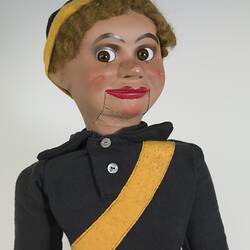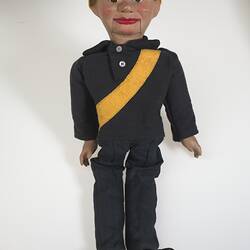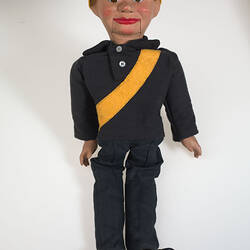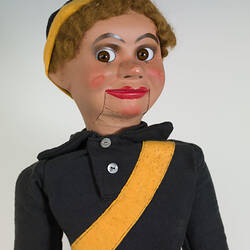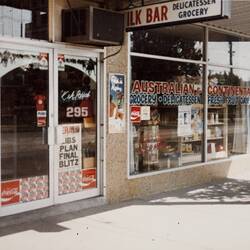Summary
Boxed Richmond Football Club Barracker Gerry Gee Special (Glass Moving Eyes) Ventriloquist Doll.
This ventriloquist doll was produced in Melbourne by the Sterne Doll Company as part of a range of toys based on the TV ventriloquist doll Gerry Gee, star of Channel 9's `The Tarax Show'. They brought out Gerry dolls dressed in supporter outfits for all of the VFL teams.
Physical Description
Painted plaster doll with moving (weighted) glass eyes and movable mouth mechanism. Has a light brown mohair wig, and is dress in a knitted black with yellow diagonal strip football jersey, with two white plastic buttons, black cotton pants, white cotton socks and black moulded shoes. The doll is contained in a long rectangular cardboard box with fitted lid, both of which has paper labels, with photographs, describing the doll.
Significance
The L J Sterne collection is significant as one of the few surviving collections related to an Australian toy and doll manufacturer, a once thriving industry in Australia. Only the Lindsay Archive at the Powerhouse Museum (documenting a children's fancy dress maker of the 1950s - 1980s) and the Jakas collection at Museum Victoria (documenting a soft toy maker of the 1960s - 1990s) are comparable.
Leo Sterne arrived in Melbourne as a refugee from Austria at the outbreak of World War II in 1939. Looking for ways to earn a living, Sterne noticed that there was a shortage of dolls and toys in Melbourne as many of these had previously been imported from Germany and Japan. He began by experimenting in his East Malvern garage with various forms of papier mache to produce dolls heads, and later complete dolls. It was so successful that he soon was running a thriving operation with three other employees.
By 1946 business had expanded to such an extent that a full scale factory was established by Sterne in Leicester Street, Carlton. The Sterne Doll range now included various fashion and bridal dolls, as well as baby dolls and national costume dolls, an expanse enabled by the addition of latex moulding equipment. By 1950, Sterne Dolls had a staff of 30, as well as sales representatives in Sydney, Brisbane, Perth, Adelaide and Hobart.
The next phase of the company's development occurred in 1958 when Sterne was approached by TV ventriloquist Ron Blaskett, who performed on the children's show `The Tarax Club' on GTV Channel 9. He had seen examples of Sterne's work and wanted him to produced replicas of his doll `Gerry Gee' for sale to the public. The `Gerry Gee Junior' doll was born, and can be considered the first real example of Television merchandising in Australia. With continuous daily TV advertising, sales went through the roof, and Sterne had to employ more staff to cope with the demand.
The `Geraldine Gee' doll, Gerry' sister, was added in 1960 to cater for female viewers. Throughout the early and mid 1960s several new styles of `Gerry Gee Juniors' were produced to reflect contemporary fashions - these included the Football Supporter (1961), Cowboy and Cowgirl (reflecting the popularity of American Westerns, in 1963), Beatles Gerry (to coincide with the Beatles tour in 1964) and Space Gerry and Geraldine (reflecting the interest in Space and Science Fiction in the lead up to the first walk on the moon in 1969.)
Sterne also manufactured soft toys representing other Australian children's television characters, including Humphrey Bear (from `Here's Humphrey) and Fredd and Fifi Bear (from `The Magic Circle Club') Sterne finally retired when he sold the business in 1971. Sterne Dolls seems to have disappeared soon after this, possibly a victim of the import tariff reductions introduced by the Whitlam Government in 1973, which saw local markets inundated with cheaper imported goods, particularly from Asia.
The Richmond Football Club was founded on February 10th, 1885 at the Royal Hotel in Richmond. Their first game, under the VFA competition, was against Cremone at the Richmond Cricket Ground (later the Punt Road Oval) on April 25th, 1885, with Richmond winning by 14 points.
After triumphing in the smaller VFA, Richmond was finally invited to join the VFL in 1908. With the current uniform style adopted in 1914, Richmond experienced its first `golden age' from 1919 and 1934, winning the premiership 4 times and was runner up on 7 occasions. In 1931, Jack Dyer made his senior debut with Richmond, and was later dubbed `Captain Blood' as he played 312 games, and then went on to coach them between 1941 and 1952.
Richmond finally shifted its home ground to the MCG in 1965, heralded its second `golden age' as players such as Royce Hart, Francis Bourke and Kevin Bartlett and coach Tom Hafey led Richmond to four premierships and second place between 1967 and 1974. Surprising by 1980. Due to a dwindling membership, Richmond was in danger of folding and it was only due to austere budgeting and the very successful "Save Our Skins" advertising campaign that the club survived. It now has one of the AFL's most passionate supporter bases and is considered, along with Collingwood, Carlton and Essendon, as one of the `Big Four' Melbourne clubs.
More Information
-
Collection Names
-
Collecting Areas
-
Acquisition Information
Purchase
-
Manufacturer
Sterne Doll Company, 121-123 Leicester Street, Carlton, Greater Melbourne, Victoria, Australia, 1962-1966
-
Person Depicted
Gerry Gee, 121-123 Leicester Street, Carlton, Greater Melbourne, Victoria, Australia, 1962-1966
-
Inscriptions
Printed on front of box: GERRY GEE/ Special/ CHANNEL GTV9
-
Brand Names
-
Classification
-
Category
-
Discipline
-
Type of item
-
Overall Dimensions
590 mm (Length), 225 mm (Width), 130 mm (Height)
Dimensions of box (doll is kept inside it.)
-
Keywords
Australian Rules Football, Australian Television Industry, Dolls, Performers, Television Publicity

